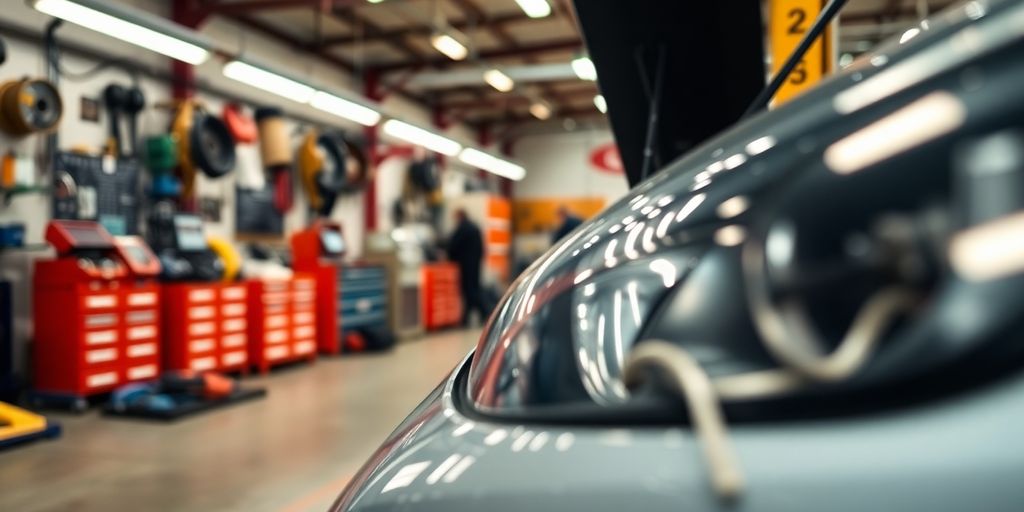SEO for automotive businesses is like having a GPS for your online presence. It’s all about making sure your car dealership or auto parts store shows up when potential customers are searching online. With the automotive industry getting more competitive, understanding SEO can give you a leg up. This article breaks down the basics, from keyword strategies to local SEO, and how these elements can drive more traffic to your site and ultimately boost sales.
Key Takeaways
- SEO helps car dealerships rank higher in search engine results, making them more visible to potential customers.
- Using the right keywords is crucial for attracting the right audience to your automotive website.
- Local SEO is essential for automotive businesses to connect with nearby customers.
- On-page optimization, like improving meta tags and content quality, can significantly enhance your site’s performance.
- Regularly measuring SEO success through KPIs and analytics helps in adapting strategies for better outcomes.
Understanding Automotive SEO Strategies
Defining Automotive SEO
Automotive SEO is all about making sure car dealership websites show up when people search online. It’s like tuning a car to make it run just right, but for websites. You tweak things like keywords, meta tags, and content so they rank higher on search engines like Google. This means when someone is looking for a car, your dealership pops up in their search results.
Importance of SEO in the Automotive Industry
In the auto world, SEO isn’t just a nice-to-have; it’s a must. With so many people starting their car buying journey online, having a strong SEO strategy is crucial. Without it, even the best car deals can go unnoticed. SEO helps bring more visitors to your site, which can lead to more sales. It’s like having a giant neon sign pointing people to your dealership.
Key Components of an Effective SEO Strategy
Creating a solid SEO plan involves a few key steps:
- Keyword Research: Find out what terms people use when searching for cars or dealerships. This helps you target the right audience.
- On-Page Optimization: Make sure your website’s pages are set up properly. This includes using the right keywords, having clear headings, and making sure the site is easy to navigate.
- Content Creation: Regularly update your site with fresh, relevant content. This can be blog posts, videos, or even customer testimonials.
- Technical SEO: Ensure your site loads quickly and works well on mobile devices. Nobody likes a slow site.
In the fast-paced world of automotive sales, staying ahead with SEO is like having a well-tuned engine. It keeps your business running smoothly and helps you reach new customers effectively.
The Role of Keywords in Automotive SEO
Identifying Relevant Keywords
In the world of automotive SEO, keywords are the backbone of any successful strategy. They help connect potential buyers with the vehicles or services they are searching for. Identifying the right keywords involves understanding your audience’s search behavior and the terms they use when looking for cars or automotive services. This can be achieved through tools like Google’s Keyword Planner or SEMrush, which provide insights into search volumes and competition levels. By focusing on relevant keywords, dealerships can better target their content to capture the right audience.
Long-Tail Keywords for Car Dealerships
While short-tail keywords like "car dealer" or "buy car" are important, they are often highly competitive. Long-tail keywords, which are more specific phrases like "best hybrid SUVs 2024" or "affordable used cars in Chicago," can be incredibly effective. These keywords might have lower search volumes, but they often lead to higher conversion rates because they target users who are further along in the buying process. Incorporating long-tail keywords into your content strategy can significantly boost your dealership’s visibility and attract more qualified leads.
Using Keywords to Drive Traffic
Once you’ve identified the right keywords, the next step is to integrate them into your website content strategically. This includes optimizing page titles, meta descriptions, headers, and the body text of your web pages. It’s important to use keywords naturally and avoid "keyword stuffing," which can harm your site’s ranking. Instead, focus on creating informative and engaging content that naturally incorporates these keywords. By doing so, you enhance your site’s relevance and authority, which can lead to increased organic traffic and better search engine rankings.
Keywords are not just about ranking; they are about understanding your audience and providing them with the information they need.
By carefully selecting and using keywords, automotive businesses can improve their search visibility and connect with more potential customers. This approach is not just about driving traffic but also about ensuring that the traffic is relevant and likely to convert into sales. For more insights on effective SEO strategies for car dealerships, check out our SEO for car dealerships guide.
On-Page Optimization Techniques

Optimizing Meta Tags and Descriptions
Meta tags and descriptions are like the billboards of your website. They tell search engines and users what each page is about. Make sure your title tags are sharp and to the point, ideally under 60 characters. Keep meta descriptions engaging, around 150 characters, and always include your main keyword. This helps in capturing user attention and improving click-through rates.
Creating High-Quality Content
Content is king, they say, and it’s especially true for SEO. Aim to publish content that’s not just relevant but also engaging. Think about what your audience wants to read and keep it fresh. This could mean updating old posts or adding new insights. A content calendar might help you plan out topics and timelines.
Regularly refreshing your content keeps your site relevant and can boost your rankings.
Improving Website Navigation
Good navigation is like a friendly guide, helping visitors find their way around your site. Simplify your menu structure so it’s easy to understand. Use clear labels for your categories and make sure every page is reachable in just a few clicks. This not only improves user experience but also helps search engines index your site more efficiently.
To sum it up, on-page SEO is all about making your site easy to find and enjoyable to use. From meta tags and descriptions to content and navigation, each element plays a part in making your automotive business more visible online.
Local SEO for Automotive Businesses
Importance of Local SEO
In the car industry, local SEO is super important. Why? Most folks prefer buying cars from nearby dealerships. So, if you want to be found by these potential customers, you need to focus on local SEO. This means tweaking your online presence to show up in local search results. It’s not just about being seen; it’s about being seen by the right people in your area.
Claiming Your Google Business Profile
One of the first steps in boosting your local SEO is claiming your Google Business Profile. This is like your business’s online ID card. It helps you appear in local searches and on Google Maps. Make sure your profile is complete with accurate info like address, phone number, and business hours. Keeping this updated can really help you stand out from the competition.
Building Local Citations
Building local citations means getting your business name, address, and phone number listed on other websites. These could be local directories, social media platforms, or review sites. The more places your business info appears, the more trustworthy you seem to search engines. Here’s a quick list to get started:
- Add your details to local business directories.
- Ensure your info is consistent across all platforms.
- Encourage satisfied customers to leave reviews on your profiles.
Local SEO isn’t just a strategy; it’s about connecting with your community. By focusing on local elements, you’re not just boosting your search engine rankings. You’re making it easier for your neighbors to find and trust you.
Technical SEO Considerations
Website Speed and Performance
In today’s fast-paced online world, website speed is a big deal. If your site takes forever to load, users will likely bail before even seeing what you offer. Search engines also take note, ranking faster sites higher. So, how do you speed up your site? Start by compressing images, minimizing code, and cutting down on unnecessary scripts. A quick site means happier visitors and better SEO.
Mobile Optimization
With most people using their phones to browse, having a mobile-friendly site isn’t optional—it’s a must. You’ve got to make sure your site works smoothly on any device, whether it’s a phone, tablet, or desktop. Use responsive design, which automatically adjusts your site’s layout based on the screen size. Also, keep an eye on mobile usability through tools like Google Search Console. This ensures your site not only looks good but performs well on mobile devices.
Structured Data for Automotive Websites
Adding structured data, like Schema markup, can help search engines understand your site’s content better. For automotive businesses, using structured data can highlight important details like car specs, dealership locations, or service offerings. While it might not directly boost your search rankings, it can enhance your search listings, making them more attractive to users. This can lead to higher click-through rates, giving you an edge over competitors.
Measuring SEO Success in the Automotive Sector

Key Performance Indicators (KPIs)
When it comes to understanding how well your SEO efforts are working, Key Performance Indicators (KPIs) are your best friends. They give you a snapshot of what’s happening. For automotive businesses, some essential KPIs include organic traffic, conversion rates, and bounce rates. Tracking these metrics helps you see what’s working and what needs tweaking. Let’s break it down a bit:
- Organic Traffic: This is the number of visitors coming to your site through search engines without paid ads. More is generally better.
- Conversion Rates: This shows the percentage of visitors who take a desired action, like filling out a contact form or scheduling a test drive.
- Bounce Rates: This measures how many visitors leave after viewing just one page. A high bounce rate might mean your content isn’t engaging.
Using Analytics Tools
To really get into the nitty-gritty, you’ll need some analytics tools. Google Analytics is a popular choice. It offers a wealth of data about your site’s performance. With it, you can track how visitors find your site, what pages they’re looking at, and how long they’re sticking around. Another tool to consider is Google Search Console, which provides insights into your search traffic and performance.
- Google Analytics: Offers detailed insights into user behavior and traffic sources.
- Google Search Console: Helps monitor your website’s presence in Google search results.
- Call Tracking Software: Especially useful for car dealerships, as many initial contacts are made via phone.
Adapting Strategies Based on Data
Once you have all this data, what do you do with it? The answer is simple: adapt. Data-driven decisions can significantly improve your SEO strategy. If a particular keyword is driving traffic, double down on it. If a page has a high bounce rate, maybe it’s time to refresh the content or improve the user experience.
It’s not just about collecting data but using it to make informed decisions that drive better results. The automotive industry is competitive, and staying ahead means constantly refining your approach.
By regularly reviewing your KPIs and using analytics tools to gather insights, you can ensure your SEO strategies are always moving in the right direction. Remember, SEO isn’t a one-time effort but an ongoing process of improvement.
Integrating SEO with Other Marketing Efforts
Combining SEO with Paid Advertising
In the world of automotive marketing, combining SEO with paid advertising can be a game changer. While SEO helps improve your site’s organic visibility, paid search offers instant results. Together, they create a powerful duo that can dominate search engine results pages. For example, you can test keywords using paid ads to see which ones drive the most traffic, then apply those learnings to your SEO efforts. This way, you’re not just guessing which keywords work; you’re using data to make informed decisions.
Social Media and SEO Synergy
Social media isn’t just for sharing cat videos and memes. It’s a valuable tool for driving traffic to your website and improving your SEO. By sharing your content on platforms like Facebook and Instagram, you increase its visibility and potential for backlinks. Plus, engaging with your audience on social media can boost your brand’s credibility, which search engines love. Remember, the more your content is shared, the more likely it is to be seen by a wider audience.
Content Marketing Strategies
Content is king, especially when it comes to SEO. Creating high-quality, relevant content not only attracts visitors but also keeps them on your site longer. This reduces bounce rates and signals to search engines that your site is valuable. Consider developing a content calendar to plan out blog posts, videos, and other content types. This ensures you consistently produce fresh content that resonates with your audience.
Integrating SEO with other marketing channels is like having a well-oiled machine. Each part works together to drive your business forward, reaching more potential customers and ultimately boosting sales. Don’t overlook the power of a coordinated strategy—it’s the secret sauce to success in the automotive industry.
- Use three essential SEO strategies designed to enhance car dealerships’ search rankings.
- Share engaging content on social media to increase visibility.
- Test keywords with paid ads to inform your SEO strategy.
Wrapping It Up
So, there you have it. SEO for automotive businesses isn’t just a buzzword; it’s a real game-changer. Whether you’re running a car dealership or an auto parts store, getting your SEO strategy right can make all the difference. It’s about making sure your business shows up when potential customers are searching online. And let’s face it, everyone is online these days. Sure, it takes some effort and a bit of know-how, but the payoff can be huge. More visibility means more traffic, and more traffic can lead to more sales. So, if you haven’t already, it’s time to dive into the world of SEO and see how it can drive your business forward. Remember, in the digital age, being seen is everything.
Frequently Asked Questions
What is SEO for automotive businesses?
SEO for automotive businesses is a way to make car dealership websites more visible on search engines. It involves using keywords, optimizing web pages, and improving local search results to attract more visitors.
Why is SEO important for car dealerships?
SEO is important for car dealerships because it helps them appear in search engine results, making it easier for potential customers to find them online. This can lead to more visitors and more sales.
How do keywords help in automotive SEO?
Keywords help in automotive SEO by matching the words and phrases people use when searching for cars online. Using the right keywords can make a dealership’s website appear higher in search results.
What is local SEO and why is it important for car dealers?
Local SEO focuses on improving a dealership’s visibility in local search results. It’s important because it helps local customers find nearby dealerships, which can increase foot traffic and sales.
How can car dealerships improve their website’s SEO?
Car dealerships can improve their website’s SEO by optimizing meta tags, creating quality content, and ensuring the site is mobile-friendly and fast. They should also claim their Google Business Profile and build local citations.
What are some technical SEO considerations for automotive websites?
Technical SEO considerations for automotive websites include improving site speed, ensuring mobile optimization, and using structured data to help search engines understand the content better.






